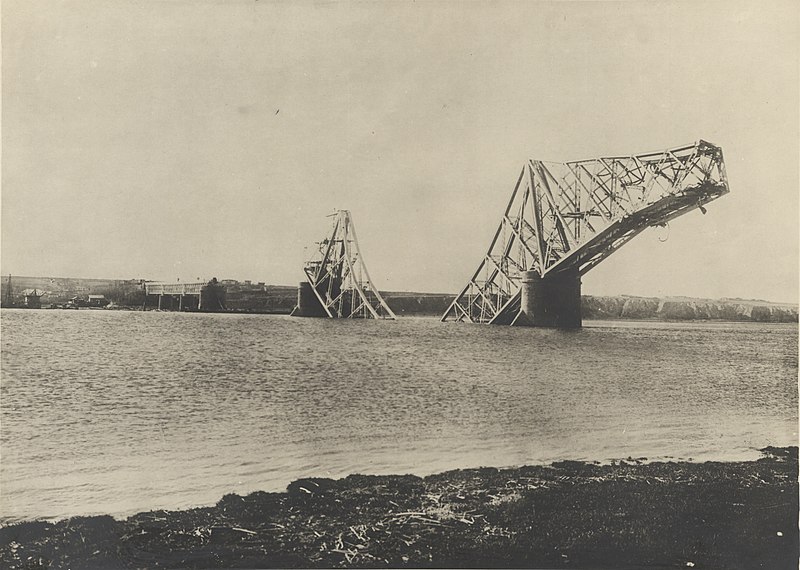Inaugurated in 1895, the Cernavodă Bridge, designed and built by Anghel Saligny, was the longest in Europe. The bridge had long secured the rail link between Bucharest and Constanţa, the main Romanian port on the Black Sea. This bridge of vital importance for the railway transport in Romania was just one step away from being blown up during the First World War, at the initiative of a Romanian general.
In 1890, Anghel Saligny, a young 34-year-old engineer, was given the task of building a bridge over the Danube to Dobruja, a province that became a part of Romania after the Treaty of Berlin (1878). The works lasted 5 years, the bridge being inaugurated on September 26, 1895, in the presence of King Carol I.
The bridge over the Danube has a central opening of 190 meters and four other 140-meter openings, alongside a viaduct with 15 openings of 60 meters each. The bridge is 30 m above the level of the Danube to allow vessels to pass underneath it. In addition, a second railway bridge was completed over the arm of the Danube called Borcea, which also delimitated the island with the same name. The bridge over the Borcea comprises 3 openings of 140 meters and a viaduct with 11 openings spanning 50 meters.

On Borcea Island, which was crossed by a 14 km section of the railway, a viaduct with 34 openings spanning 42 meters was made. With the access ramps, the 4087.95 meters of bridges formed at that time the longest bridge complex built in Romania and the third largest in the world. The central opening of 190 m was the largest in mainland Europe.
In the autumn of 1916, after the defeat in the Battle of Tutrakan (1-6 September 1916), the situation in Romania worsened significantly. The troops of the Central Powers quickly advanced to Dobruja, occupying a large part of the province. The Cernavodă Bridge had become a vital objective for Romania’s defence. If the Central Powers were able to capture the bridge, they would have had easy access to Bucharest.
Averescu: “I think the general should be blown up, not the bridge”
Rumours reach the Royal Family that the Cernavodă Bridge was blown up by retreating Romanian troops. Queen Marie wrote in her diary on October 10, 1916:“[…] Dobruja is almost lost, Constanța was taken, our men, with their very hands, blew up the big bridge- the bridge so dear to my uncle which warmed his heart, the bridge in front of which my aunt stared ecstatically when we were traveling on the Danube. I do not know how high are the losses, but the situation is serious and there is talk of evacuation again”.
The information was wrong. There were plans to destroy the bridge, but these were hindered by General Alexander Averescu, newly appointed (on September 26, 1916) as Commander of the Second Army, on the southern front. General Alexander Socec, at that time commander of the 2nd Infantry Division, subsequently degraded and sentenced to jail by the Military Tribunal for leaving his post during the Battle for Bucharest, asked for Averescu’s permission to blow up the Cernavodă Bridge. The reply written back by Averescu became famous: “I think the general should be blown up, not the bridge”.
In those moments dominated by confusion, the public opinion in Bucharest did not know the situation of the bridge. On October 12, the writer and politician Vasile Th. Cancicov, noted in his diary:“The loss of Constanța immediately caused the loss of Medgidia and Cernavodă. Militarily, economically, and politically, the loss is immeasurable. So far, the fate of the Cernavodă bridge is unknown”.
The destruction of the bridge over the Borcea Arm
The firm intervention by General Averescu saved the Cernavodă Bridge from being destroyed, but the advance of the Central Powers troops across the Danube had to be stopped. For this purpose, it was decided to destroy the secondary bridge, namely the section that crossed the Borcea Arm, which was rigged with demolition charges by the withdrawing Romanian troops, in order to prevent the advancement of the German-Bulgarian troops. The Borcea Bridge was rebuilt in 1921.
Bibliography:
Marie, the Queen of Romania, Jurnal de război (I). 1916-1917 [War Diary (I). 1916-1917], Humanitas Publishing House, Bucharest, 2014.
Vasile Th. Cancicov, Jurnal din vremea ocupaţiei. Impresiuni şi păreri personale din timpul războiului României. Jurnal zilnic. 13 august 1916- 13 august 1917 [Diary from the time of occupation. Personal impressions and opinions during Romania’s war. Daily journal, August 13, 1916- August 13, 1917], Humanitas Publishing House, Bucharest, 2015.
Gheorghe Platon (coord.), Istoria Românilor [The history of the Romanians], vol. VII, tome II, Encyclopaedic Publishing House, Bucharest 2003.
Translated by Laurențiu Dumitru Dologa

